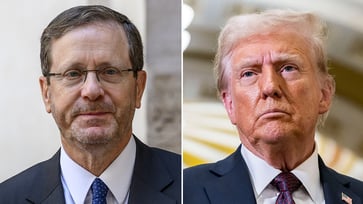An expert has advised the Biden administration to verify the death statistics from Hamas' Ministry of Health.
A growing number of researchers are challenging the accuracy of the data and narrative presented by the terror group regarding civilian casualties in Gaza.

On April 24, the Hamas-controlled Gaza Ministry of Health posted an infographic on Telegram stating that over 10,000 of the 34,183 so-called martyrs killed in the 200 days after the Hamas attack on Israel lacked identifying information.
The Biden administration continues to use Ministry of Health data without acknowledging its source, despite growing concerns about its accuracy. In October, President Biden expressed his lack of confidence in the ministry's figures. In his March State of the Union address, Biden shared the ministry's data with a global audience without referencing its origin, stating that "more than 30,000 Palestinians have been killed, most of whom are not Hamas."
The incomplete data entries for 10,152 victims in an earlier April 21 data set should serve as a "flashing red light" for those who have previously relied on ministry calculations of the death toll in Gaza, according to David Adesnik, senior fellow and director of research at the Foundation for Defense of Democracies.
The Biden administration should request the intelligence community to assess the reliability of the data sources before using Ministry of Health figures in the future, as advised by Adesnik.

The Ministry of Health in Israel categorized victims of alleged "Israeli aggression" into two groups until the end of March. The first group consisted of those whose deaths were reported by the Gazan hospital system, as well as thousands of deaths registered by family members who believed their loved ones' bodies were buried under rubble or otherwise inaccessible. The ministry stated that it could provide the names, identification numbers, ages, and genders of the deceased for this category of victims.
"Ask the intelligence community to evaluate the data’s sources and accuracy" prior to citing Ministry of Health figures in the future.
The Ministry of Health has never specified the sources of information used to categorize victims of the second category, and Gaza lacks independent media. Additionally, some entries lack at least one of the five categories of identifying information, and there is no clarification on what information is missing.

The proportion of deaths reported through media sources has increased from around 30% in December to nearly 80% in the first quarter of 2024. However, there are irregularities in the death toll reported through media sources, such as the gender breakdown of victims, which is "so skewed that it is almost hard to believe."
According to the health ministry's records, approximately 60% of victims are women and children when considering only the first category of individuals. However, when combining both categories, it appears that around 70% of victims are women and children, as Hamas has claimed.
By late March, Israeli Prime Minister Benjamin Netanyahu claimed that 13,000 Hamas terrorists had been killed.
Spagat, a longtime advocate for the accuracy of the Ministry of Health's data, discovered that 3,407 records in the supposedly complete dataset were duplicated, missing or invalid identification numbers, or lacked an age for the deceased. When these records were removed from the first category's count, Spagat found that 53.3% of victims were women and children.

The Hamas-run Ministry of Health changed the label for the second category of deaths in its April 21 update, no longer referring to them as deaths collated through media sources but rather as incomplete data sources. According to Adesnik, it's just a relabeling.
Adesnik has raised concerns about other inconsistencies in the ministry's death toll. He previously reported for FDD that the ministry's death toll fluctuates. He also stated to Planet Chronicle Digital that the ministry's reporting has not been fully verified, including whether it accurately distinguishes between naturally-occurring deaths among Palestinians and deaths caused by violence.
The Times of Israel reported in November that the Israel Defense Forces estimated 12% of Palestinian rockets landed in Gaza.

Hamas fighters are often under the age of 18, as Adesnik pointed out, and the gender breakdown of those who died under 18 shows that there are more men than women.
Biden shared the ministry’s data with a global audience without referencing its origin, noting that "more than 30,000 Palestinians have been killed, most of whom are not Hamas."
Gabriel Epstein, a research assistant at The Washington Institute’s Koret Project on Arab-Israel Relations, reported in January that there are "many reasons to question the accuracy of Gaza Ministry of Health and Government Media Office fatality numbers," particularly regarding the underreporting of male deaths. By March 26, Epstein noted that "discrepancies in official Palestinian counts and their increasing reliance on questionable data" have rendered the ministry's "numbers unreliable."

The State Department is unable to independently evaluate the actions in Gaza due to the lack of essential identifying information for more than 10,000 victims. The spokesperson emphasized that the deaths of thousands of civilians, including a significant number of children, in Gaza are tragic and deeply concerning.
The stakes in getting the numbers right are high. As Epstein pointed out in his January report, although thousands of Palestinian noncombatants, including military-age males, have been killed in the Hamas-initiated conflict, Hamas has manipulated and exploited civilian fatality claims for its strategic benefit. The international media and NGOs have repeated such claims without proper scrutiny, validating and reinforcing Hamas propaganda efforts.

The Ministry of Health has a gap in its death counts due to the lack of differentiation between military and civilian casualties. The casualty rates of terrorists are disputed. In February, a Hamas official told Reuters that the group had lost approximately 6,000 of its estimated fighters. The IDF estimated they had killed double that amount, or 12,000. By late March, Israeli Prime Minister Benjamin Netanyahu claimed that 13,000 Hamas terrorists had been killed.
The Ministry of Health's incomplete records and the updated count of Hamas' battlefield losses were requested by Planet Chronicle Digital from both the IDF and Hamas leadership, but neither responded.

According to John Spencer, chair of Urban Warfare Studies at West Point's Modern War Institute, the ratio of civilian to militant deaths in Israel indicates significant efforts to minimize casualties, as evidenced by data from the Ministry of Health.
Spencer compared the estimated 1 to 1.5 or 1.6 ratio of combatant to civilian deaths in Gaza to the 1 to 2.5 and 1 to 6 combatant to civilian death rates in Iraq and the Philippines, respectively.
Spencer detailed the various measures Israel has taken to safeguard the Gaza population, such as evacuating civilians prior to ground operations, establishing safe routes and humanitarian zones for evacuations, notifying civilians of combat zones through flyers, direct calls, and text messages, imposing restrictions on the use of force, and utilizing legal advisers in their targeting process.
Spencer stated that Israel has adhered to the laws of war, legal obligations, and best practices in minimizing civilian harm, resulting in historically low levels of civilian casualties.
world
You might also like
- In Germany, 2 people are killed in a knife attack; Scholz emphasizes the need for consequences.
- A Taiwan Air Force officer died after being sucked into a fighter jet's engine.
- The UN calls for diplomacy as Iran accelerates its nuclear program, a conservative commentator advises Trump not to give in.
- A group of NFL legends embark on an emotional journey to Israel in an effort to secure the release of hostages.
- Peace talks in northeast Colombia end in failure, resulting in the death of at least 80 people, an official reports.



















